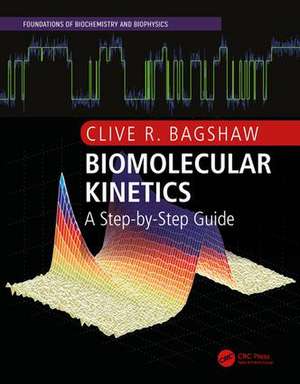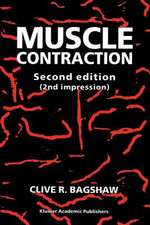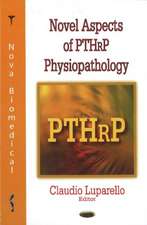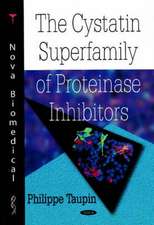Biomolecular Kinetics: A Step-by-Step Guide: Foundations of Biochemistry and Biophysics
Autor Clive R. Bagshawen Limba Engleză Paperback – 5 oct 2017
–Mark Leake, University of York
"destined to become a standard reference…. Not just a ‘how to’ handbook but also an accessible primer in the essentials of kinetic theory and practice."
–Michael Geeves, University of Kent
"covers the entire spectrum of approaches, from the traditional steady state methods to a thorough account of transient kinetics and rapid reaction techniques, and then on to the new single molecule techniques"
–Stephen Halford, University of Bristol
This illustrated treatment explains the methods used for measuring how much a reaction gets speeded up, as well as the framework for solving problems such as ligand binding and macromolecular folding, using the step-by-step approach of numerical integration. It is a thoroughly modern text, reflecting the recent ability to observe reactions at the single-molecule level, as well as advances in microfluidics which have given rise to femtoscale studies. Kinetics is more important now than ever, and this book is a vibrant and approachable entry for anyone who wants to understand mechanism using transient or single molecule kinetics without getting bogged down in advanced mathematics.
Clive R. Bagshaw is Emeritus Professor at the University of Leicester, U.K., and Research Associate at the University of California at Santa Cruz, U.S.A.
| Toate formatele și edițiile | Preț | Express |
|---|---|---|
| Paperback (1) | 854.09 lei 6-8 săpt. | |
| CRC Press – 5 oct 2017 | 854.09 lei 6-8 săpt. | |
| Hardback (1) | 1134.43 lei 6-8 săpt. | |
| CRC Press – 3 oct 2017 | 1134.43 lei 6-8 săpt. |
Preț: 854.09 lei
Preț vechi: 1032.68 lei
-17% Nou
Puncte Express: 1281
Preț estimativ în valută:
163.47€ • 170.02$ • 136.99£
163.47€ • 170.02$ • 136.99£
Carte tipărită la comandă
Livrare economică 13-27 martie
Preluare comenzi: 021 569.72.76
Specificații
ISBN-13: 9781498727235
ISBN-10: 1498727239
Pagini: 470
Ilustrații: 256 Line drawings, black and white; 44 Halftones, black and white
Dimensiuni: 203 x 254 x 28 mm
Greutate: 0.95 kg
Ediția:1
Editura: CRC Press
Colecția CRC Press
Seria Foundations of Biochemistry and Biophysics
ISBN-10: 1498727239
Pagini: 470
Ilustrații: 256 Line drawings, black and white; 44 Halftones, black and white
Dimensiuni: 203 x 254 x 28 mm
Greutate: 0.95 kg
Ediția:1
Editura: CRC Press
Colecția CRC Press
Seria Foundations of Biochemistry and Biophysics
Public țintă
Postgraduate and UndergraduateCuprins
Introduction. Kinetic Theory. Some Underlying Physical Principles. Enzyme Kinetics. Beyond Enzyme Kinetics. Experimental Strategies. Instrumentation. Data Analysis. Single-Molecule Kinetics. Kinetic Thinking: Back To The Future. Appendices
Notă biografică
Clive Bagshaw obtained a BSc in Biochemistry at the University of Birmingham and a PhD from the University of Bristol. His thesis involved investigation of muscle myosin ATPase activity using transient kinetic methods. The resultant kinetic mechanism, proposed together with his supervisor David Trentham, became textbook information. Following post-doctoral periods at the Universities of Pennsylvania and Oxford, he obtained a lectureship at the University of Leicester, where he taught courses on protein structure and function for 30 years. He continued his research of myosin ATPase activity, initially using a home-built stopped-flow apparatus based on the Gutfreund design. Subsequently, his instrument arsenal was extended, in collaboration with other faculty members, to include commercial stopped-flow, quenched-flow, temperature-jump and flash photolysis instruments. His own research was extended into the mechanisms of myosin ATPase regulation by Ca2+ ions and the kinetics of non-muscle myosins. He wrote a short textbook on Muscle Contraction in 1982, which was revised and extended in 1993 to include in vitro motility assays. The latter was inspired by a sabbatical period in Jim Spudich's laboratory at Stanford University. On return to Leicester, he constructed a total internal reflectance fluorescence microscope to study ATP turnover by myosin at the single-molecule level. In the search for suitable fluorescence probes, he also studied the photophysics of a number of variants of green fluorescent proteins. More recently, he has been involved in collaborative research on other cytoskeletal proteins, S100 proteins, splicing factors and DNA-based photonic wires. From year 2000, Clive has been an instructor on the biannual EMBO Practical Course on Transient Kinetics held at the University of Kent. In 2002 he obtained a personal chair in physical biochemistry and retired from Leicester University in 2011. This transition was catalyzed by a sabbatical at the University of California at Santa Cruz in the laboratory of Michael Stone, which led to an honorary research position that provided the academic resources and freedom to write this book on kinetics. He continues to assist in research using single-molecule methods to study telomerases and enjoy the spectacular natural history of the Monterey Bay.
Recenzii
"a unique and innovative contribution to the field... the first to my knowledge that covers the entire spectrum of approaches, from the traditional steady state methods to a thorough account of transient kinetics and rapid reaction techniques, and then on to the new single molecule techniques… a significant contribution."
—Prof. Stephen Halford, University of Bristol
" Enzyme kinetics is regaining its rightful place at the center of molecular and cellular biology…. Thus, a new generation of students will benefit from Clive Bagshaw's Biomolecular Kinetics: A Step-By-Step Guide"
—Jonathon Howard, Eugene Higgins Professor of Molecular Biophysics & Biochemistry, Yale
"Comprehensive and well written."
—Enrico Di Cera, MD, Alice A. Doisy Professor and Chairman, Department of Biochemistry and Molecular Biology, Saint Louis University
"This book is destined to become a standard reference on the bookshelf of any laboratory with an interest in kinetic approaches to biology. Not just a ‘how to’ handbook but also an accessible primer in the essentials of kinetic theory & practice."
—Prof. Michael Geeves, University of Kent
"This book is a much needed modern update for the underserved field of biomolecular kinetics. It covers the practical ‘how to’ and troubleshooting information for experiments together with the fundamentals in one place. It is written by a genuine expert in kinetic techniques, and is beautifully illustrated. It is highly accessible to readers at all levels, and I highly recommend this text to anyone wishing to learn more about the power and potential applications of kinetics techniques."
—Prof. Emma Raven, University of Leicester
"a gem of a textbook which manages to produce a genuinely fresh, concise yet comprehensive guide through the nuances of biomolecular kinetics, penned by one of the giants of this complex but fundamental field of the life sciences"
—Prof. Mark Leake, University of York
"This well written, concise but very comprehensive text will be the go-to book for those wanting to take advantage of new (and classic) approaches, and the challenges and the opportunities they provide."
—Bob Callender, Professor of Biochemistry, Albert Einstein College of Medicine
"This is a comprehensive and detailed yet clear and much needed book. Kinetic methods are applied throughout biological sciences and for everyone who is using them this is a must-read."
—Per Jemth, Department of Medical Biochemistry and Microbiology, Uppsala University
"Finally, a book that supports a practical entry into kinetics for enzymologists and other biochemists. The field sorely needs a solid, accessible kinetics text like this…."
—Bruce A. Palfey, Department of Biological Chemistry, University of Michigan Medical School
"a lively book with a splendid balance between the description of most recent experimental work and easily comprehensible theoretical interpretations…. [It] should help to encourage students to enter this exciting field and help research workers to expand the range of their endeavours."
—Herbert Gutfreund, University of Bristol
—Prof. Stephen Halford, University of Bristol
" Enzyme kinetics is regaining its rightful place at the center of molecular and cellular biology…. Thus, a new generation of students will benefit from Clive Bagshaw's Biomolecular Kinetics: A Step-By-Step Guide"
—Jonathon Howard, Eugene Higgins Professor of Molecular Biophysics & Biochemistry, Yale
"Comprehensive and well written."
—Enrico Di Cera, MD, Alice A. Doisy Professor and Chairman, Department of Biochemistry and Molecular Biology, Saint Louis University
"This book is destined to become a standard reference on the bookshelf of any laboratory with an interest in kinetic approaches to biology. Not just a ‘how to’ handbook but also an accessible primer in the essentials of kinetic theory & practice."
—Prof. Michael Geeves, University of Kent
"This book is a much needed modern update for the underserved field of biomolecular kinetics. It covers the practical ‘how to’ and troubleshooting information for experiments together with the fundamentals in one place. It is written by a genuine expert in kinetic techniques, and is beautifully illustrated. It is highly accessible to readers at all levels, and I highly recommend this text to anyone wishing to learn more about the power and potential applications of kinetics techniques."
—Prof. Emma Raven, University of Leicester
"a gem of a textbook which manages to produce a genuinely fresh, concise yet comprehensive guide through the nuances of biomolecular kinetics, penned by one of the giants of this complex but fundamental field of the life sciences"
—Prof. Mark Leake, University of York
"This well written, concise but very comprehensive text will be the go-to book for those wanting to take advantage of new (and classic) approaches, and the challenges and the opportunities they provide."
—Bob Callender, Professor of Biochemistry, Albert Einstein College of Medicine
"This is a comprehensive and detailed yet clear and much needed book. Kinetic methods are applied throughout biological sciences and for everyone who is using them this is a must-read."
—Per Jemth, Department of Medical Biochemistry and Microbiology, Uppsala University
"Finally, a book that supports a practical entry into kinetics for enzymologists and other biochemists. The field sorely needs a solid, accessible kinetics text like this…."
—Bruce A. Palfey, Department of Biological Chemistry, University of Michigan Medical School
"a lively book with a splendid balance between the description of most recent experimental work and easily comprehensible theoretical interpretations…. [It] should help to encourage students to enter this exciting field and help research workers to expand the range of their endeavours."
—Herbert Gutfreund, University of Bristol
Descriere
Biomolecular kinetics concerns the measurement and analysis of reaction phenomena as a function of time. This book explains the methods used for measuring how much a reaction gets speeded up, as well as the framework for solving problems such as ligand binding and macromolecular folding.





















